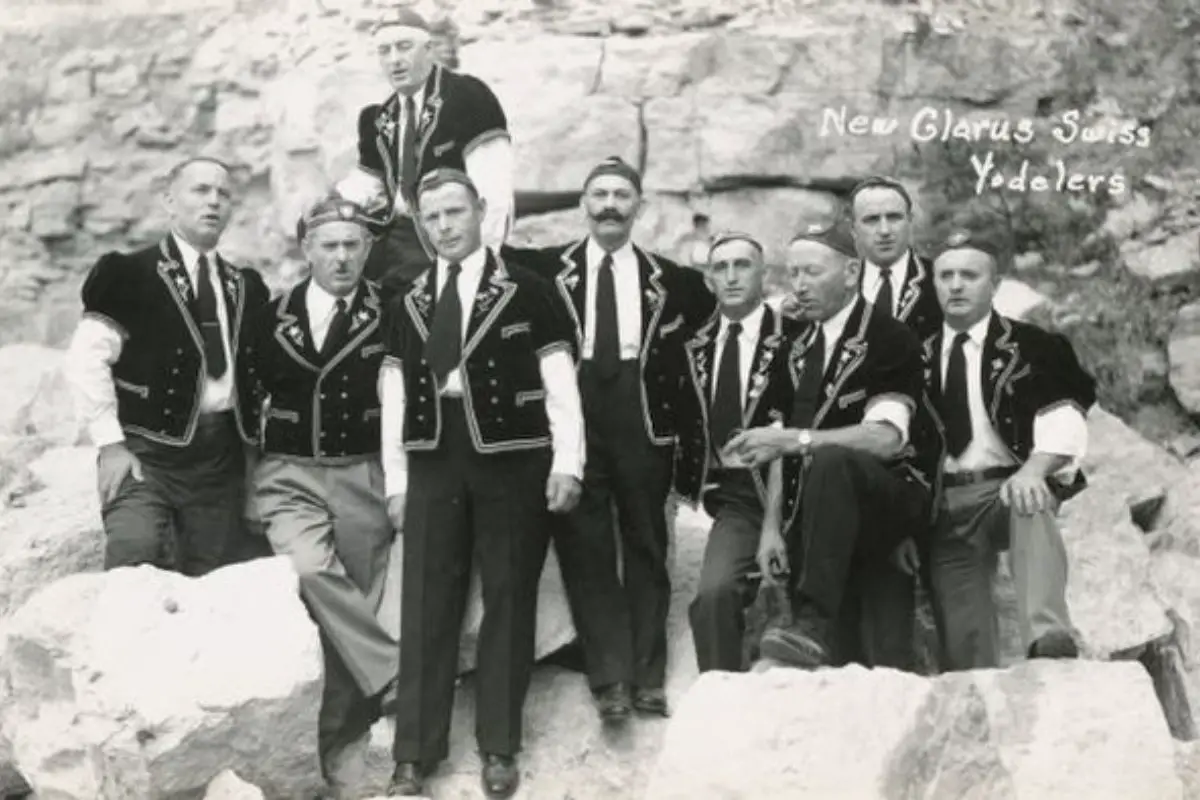Have you ever found yourself caught between admiring the joyous sounds of an Alpine hiker and wanting to make fun of the distinctive “yodel-ay-ee-oo” echoing from the hills? Well, the joke might be on us because that seemingly funny warble is more than just noise; it’s an age-old art form known as yodeling. In this post, we’ll climb the mountain of yodeling history, from its roots nestled in the snowy peaks of the Alps to its whirlwind journey across cultures and music genres.
What is yodeling? Yodeling is a form of singing that utilizes rapid changes between the chest voice and the head voice, creating a unique echo-like sound. It is a distinctive and historic vocal technique that combines communication, music, and cultural significance.
What is yodeling?
Unlike traditional singing, yodeling focuses on wordless expression and the modulation of tones. It’s like painting a picture with your voice, using only a single note as your brush and the subtle shifts in pitch as your palette. Yodeling is distinguished from traditional singing primarily by its unique utilization of rapid pitch changes between the low-pitch chest register (or “chest voice”) and the high-pitch head register (or “head voice”).

The rhythmic and lively nature of yodeling lends itself to festive occasions, bringing an infectious energy to gatherings. Imagine standing on a mountaintop, surrounded by breathtaking vistas, and hearing a yodel echo through the valleys—a joyful proclamation of life and nature’s grandeur. It’s no wonder that yodeling has become synonymous with celebration and uplifting spirits.
While traditional singing often maintains a more consistent pitch and tonal quality, yodeling is characterized by its distinct alternation between these registers, creating a fluctuating, echo-like melody that is instantly recognizable.
AKAI Professional MPK Mini MK3

AKAI Professional MPK Mini MK3
Where does yodeling originated from?
Yodeling is a form of singing that has been around for centuries and has roots in many different cultures. It is most commonly associated with the Alpine region of Europe, where it is still a popular form of entertainment. Yodeling has also been found in other parts of the world, including the Middle East, North Africa, and the Americas.
The earliest known recordings of yodeling date back to the 16th century in Bavaria, Germany. It is believed that yodeling was used as a form of communication between mountain dwellers and to call out to one another from great distances. Yodeling was also used as a form of entertainment at festivals, with the earliest known recordings of yodeling being performed in Bavarian taverns.
The earliest known recordings of yodeling
date back to the 16th century in Bavaria, Germany.
Yodeling became popular throughout Europe in the nineteenth century. It was particularly popular in the Alpine region, where it accompanied traditional dances and other forms of entertainment. Because the yodel could be heard over long distances, it was also used to herd livestock. Yodeling rose internationally in the early twentieth century when it was used in popular music.
This was notably true in the United States, where yodeling was popular as a novelty music and was featured in several popular tunes. Yodeling is still popular in many parts of the world, particularly in Europe’s Alpine region. It’s also popular in the United States, where country music uses it. Yodeling is a distinctive vocal expression that has been popular worldwide for centuries.
| Culture | Technique | Style |
|---|---|---|
| Swiss | High-pitched falsetto yodeling | Lyrical melodies, Alpine influence |
| Austrian | Smooth and flowing yodeling | Emphasis on storytelling |
| Tuvan | Throat-singing techniques combined with yodeling | Harmonic overtones, nomadic influence |
| Hawaiian | “Hawaiian falsetto” yodeling | Melodies reminiscent of nature |
| African | Vibrant rhythmic yodeling | Call-and-response patterns |
| Native American | Yodeling integrated with traditional chants | Spiritual and ceremonial significance |
How did yodeling facilitate communication across long distances?
The distinct sound and penetrating nature of yodeling allowed messages to carry over vast expanses, reaching far-off listeners in a way that spoken words couldn’t. By modulating the voice and creating unique patterns, yodelers could communicate intricate messages that transcended the limitations of verbal language. In essence, yodeling became a bridge connecting isolated communities and providing a sense of unity.
Dos and Don’ts of Yodeling as Communication
To effectively utilize yodeling for communication, it’s important to keep in mind some practical guidelines:
| Dos | Don’ts |
|---|---|
| Practice breath control and projection | Overuse yodeling in inappropriate or unnecessary situations |
| Understand regional variations and meanings | Use yodeling as a substitute for proper spoken language |
| Respect cultural traditions and rituals | Disregard local customs and sensitivities |
| Use yodeling as a celebration of community | Rely solely on yodeling for communication in modern contexts |
Yodeling techniques
Mastering yodeling requires a combination of lung capacity, breath control, and the ability to create voice fluctuations. Embrace the unique melody of the mountains as we explore the key techniques to master yodeling, a vocal art that marries pitch, tone, and breath in an exhilarating symphony of sound.
Yodeling is a skill that requires specific techniques to achieve its distinct sound and expressive capabilities. Let’s explore some of the fundamental techniques used by yodelers to create their enchanting melodies.
Breath control and lung capacity
Yodelers must develop strong breath control to sustain long phrases and execute seamless transitions between registers. By maximizing their lung capacity and mastering diaphragmatic breathing, yodelers can achieve the sustained and powerful vocal delivery that defines yodeling. It’s like riding a wave of air, harnessing the breath to carry emotions through the melody.
Voice fluctuations and pitch modulation

Yodeling relies heavily on voice fluctuations and pitch modulation to create its distinctive sound. The ability to seamlessly transition between vocal registers is a hallmark of yodeling. By skillfully controlling their vocal cords and manipulating pitch, yodelers evoke a sense of depth and emotion in their melodies. It’s like taking your voice on a rollercoaster ride, with thrilling twists and turns of sound.
Vowel sounds and articulation techniques
In yodeling, the focus on vowel sounds plays a significant role. Yodelers employ various articulation techniques to shape vowel sounds and create specific tonal qualities. By mastering the art of precise articulation, yodelers infuse their melodies with richness and clarity.
If you want even more great tips and information, check out the video below.
Frequently Asked Questions (FAQ)
Here are some common questions about yodeling:
How can I improve my yodeling technique?
Improving your yodeling technique requires practice, dedication, and a few key steps:
Start by developing strong breath control and lung capacity through exercises and proper breathing techniques.
1. Study and emulate the styles of experienced yodelers to learn different techniques and vocal nuances.
2. Work on transitioning between registers smoothly and practicing voice fluctuations and pitch modulation.
3. Seek guidance from vocal coaches or join yodeling workshops to receive feedback and further refine your skills.
Can anyone learn to yodel, or is it a talent you have to be born with?
Yodeling is a skill that can be learned with practice and perseverance. While some individuals may have a natural inclination towards certain vocal techniques, anyone can develop the necessary techniques and style required for yodeling. It’s all about dedicating time to training, refining your voice, and embracing the unique qualities of this captivating art form.
Are there any health risks associated with yodeling?
Yodeling, when performed with proper vocal technique and in moderation, is generally safe and enjoyable. However, as with any vocal activity, it’s essential to maintain good vocal health practices. These include staying hydrated, avoiding excessive strain on the vocal cords, and warming up properly before each practice or performance. If you experience any discomfort or voice-related issues, consult a vocal specialist for guidance.
Conclusion
As we bid adieu to this yodeling adventure, let’s remember that yodeling is not just about hitting the right notes—it’s about capturing the essence of celebration and nature’s grandeur in a single melody. So go ahead, let your voice dance with the wind, and paint the air with your vibrant tones. Embrace the joy, connect with diverse cultures, and let your yodeling journey be an ode to the beauty of music and human expression.
Let me know in the comments section below if you have any questions (I read and reply to every comment). If you found this article helpful, share it with a friend, and check out my full blog for more tips and tricks on yodeling. Thanks for reading, and keep yodeling!
Key Takeaways
This article covered yodeling, exploring its origins, techniques, cultural significance, and communication potential. Here are some key takeaways:
- Yodeling is a unique vocal technique characterized by wordless singing and modulated tones.
- It is associated with Swiss folk music but has diverse cultural variations worldwide.
- Yodeling served as a means of communication across long distances in various regions.
- Techniques such as breath control, voice fluctuations, and vowel articulation are integral to yodeling.
- Yodeling can be found in American country and Western music, showcasing its influence.
- Yodeling has a celebratory sound, evoking joy and cultural celebration.















